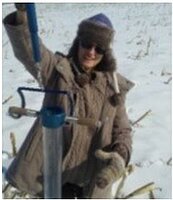Impacts of Recent Climatic Wetting on Distributed Snow and Streamflow Responses in a Terminal Lake Basin.

Diane Van Hoy is a Master of Science student in the Geological Engineering program at University of North Dakota. She obtained her B.S. in Exploration System Design with a minor in Geology from Arizona State University. Her current research is focused on deciphering the mechanism of cold region hydrologic change due to a recent precipitation increase in a terminal lake basin.
Fellow: Diane Van Hoy
Advisor: Taufique Mahmood
Degree Progress: M.S. in Geological Engineering expected graduation in Spring 2018.
Impacts of Recent Climatic Wetting on Distributed Snow and Streamflow Responses in a Terminal Lake Basin.
Devils Lake is a terminal lake that due to a recent increase in precipitation has experienced significant expansion and flooding over the last three decades. Flooding in this region has cost over a billion dollars in damage to infrastructure, and has converted valuable cropland into wetlands. This study uses a field-tested physically-based Cold Region Hydrological Model to determine how the increase in precipitation has changed the snow processes and streamflow generation mechanism, leading to multiple local and regional floods in the early 2000’s. The model is evaluated simultaneously against snow (2016-17) and streamflow (2005-2017) observations, which marks the beginning of the most recent wet period after the 1999-2004 prairie drought. Our currently modeling effort is limited to the Mauvais Coulee basin which is one of the largest subbasins contributing to Devils Lake. I also conducted a snow survey in the upper Mauvais Coulee basin during 2016-17 winter season at ten sites across estimating snow depth, density, and snow water equivalent (SWE) using a prairie snow tube. Snow cores are collected and measured to obtain the weights for calculations of snow density and snow water equivalent. Since there are currently no snow observations available, the snow survey in this project will add useful knowledge to the sparse snow observations record in DLB area. We believe that our physically-based modeling approach to reproduce intermediate hydrologic flux and variables will help us to identify mechanistic change in cold region processes due to recent wetting.
Project Objectives:
- To understand how changes in climate effect snow processes and streamflow generation using a field tested physically-based model
- Examine model sensitivity to future climate change scenarios
Progress:
To date, I conducted a detailed snow survey at distributed locations estimating snow depth, density, and snow water equivalent (SWE) using a prairie snow tube four times during winter of 2016-17. The model was evaluated against both snow and streamflow observations. Preliminary results indicate good agreement between observations and simulations. The simulated SWE maps exhibit large spatiotemporal variation during 2016-17 winter due to spatial variability in precipitation, snow redistribution from stubble field to wooded areas, and snow accumulations in small depressions across the Mauvais Coulee Basin. The main source of snow appears to be the hills and ridges of the eastern and western edges of the basin, while the main sink is the large flat central valleys.
Significance:
Since flooding is such a costly problem in this region it is important to understand the streamflow generation mechanism and how it changes with variations in climate. Knowing which factors most affect the snow accumulations and subsequent streamflow in the basin will allow scientists to better predict flooding and determine measures that can be taken to mitigate its affects.
Conference:
Van Hoy DF, Jeannotte T, Mahmood TH. 2017. “Hydrological Response to Climate Change in the Mauvais Coulee Basin.” North Dakota Established Program to Stimulate Competitive Research Conference April 2017, Fargo, North Dakota. (Poster).
Van Hoy DF, Mahmood TH, Jeannotte T, Todhunter PE. 2017. “Impacts of Recent Climatic Wetting on Distributed Snow and Streamflow Responses in a Terminal Lake Basin.” American Geophysical Union Fall Meeting Dec. 2017, New Orleans, Lousiana. (Poster).

Dr. Taufique Mahmood
Assistant Professor - Geological Engineering
Leonard Hall 324
Phone: 701-777-6959
Email: taufique.mahmood@engr.und.edu


